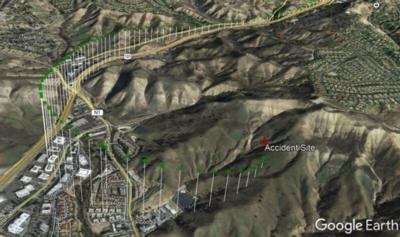Powerplant(s) Appeared To Be Operating At Time of Impact
NTSB has issued an investigative update for its ongoing investigation of the fatal, Jan. 26, 2020, helicopter crash near Calabasas, California.

The Sikorsky S-76B helicopter collided with hilly terrain and was destroyed by impact forces and fire. The pilot and eight passengers were fatally injured. The helicopter operated by Island Express Helicopters Inc., was on an on-demand passenger visual flight rules flight from John Wayne-Orange County Airport, in Santa Ana, California, to Camarillo Airport, in Camarillo, California.
"Our investigators have already developed a substantial amount of evidence about the circumstances of this tragic crash," said NTSB Chairman Robert L. Sumwalt. "And we are confident that we will be able to determine its cause as well as any factors that contributed to it so we can make safety recommendations to prevent accidents like this from occurring again.”
According to the investigative update, all significant components of the helicopter were located within the wreckage area. Examination of the main and tail rotor assemblies found damage consistent with powered rotation at the time of impact. The initial point of impact consisted of highly fragmented cabin and cockpit debris.

The main wreckage was about 127 feet from the impact and consisted of the empennage/tailboom, both engines, avionics boxes, and portions of the cockpit instrument panel. The entire fuselage/cabin and both engines were subjected to a postcrash fire. The cockpit experienced extreme fragmentation. The instrument panel was destroyed, and most instruments were displaced from their panel mounts. Flight controls were fragmented and fire damaged.
The helicopter was not equipped with a flight data recorder or cockpit voice recorder nor was it required to be for the accident flight. The NTSB has been issuing recommendations to the Federal Aviation Administration to require recorders on helicopters since 1999. Currently, safety recommendations A-13-12 and A-13-13 are the only open recommendations that address recorders in helicopters.
The helicopter operator, Island Express Helicopters, held an FAA Part 135 operating certificate ISHA094F, for on-demand VFR-only operations, since 1998 and conducted offshore oil industry support flights and charter flights. The company’s operations specifications document listed six helicopters including the accident aircraft: 1 SK-76A, 2 SK-76B, 2 AS-350-B2 and 1 AS-350-BA.
The investigative update includes a summary of the ATC and radar data, weather information as well as a summary of video and photos provided by witnesses depicting the weather at the time of the accident.
The information in the update is preliminary and subject to change as the NTSB’s investigation progresses. Analysis of the accident facts, along with conclusions and a determination of probable cause, will come at a later date when the final report on the investigation is completed. As such, no conclusions about how the incident happened should be drawn from the information contained within the investigative update.
 ANN's Daily Aero-Linx (05.02.24)
ANN's Daily Aero-Linx (05.02.24) ANN's Daily Aero-Term (05.02.24): Touchdown Zone Lighting
ANN's Daily Aero-Term (05.02.24): Touchdown Zone Lighting Aero-News: Quote of the Day (05.02.24)
Aero-News: Quote of the Day (05.02.24) ANN FAQ: Contributing To Aero-TV
ANN FAQ: Contributing To Aero-TV NTSB Final Report: Cirrus Design Corp SR20
NTSB Final Report: Cirrus Design Corp SR20




